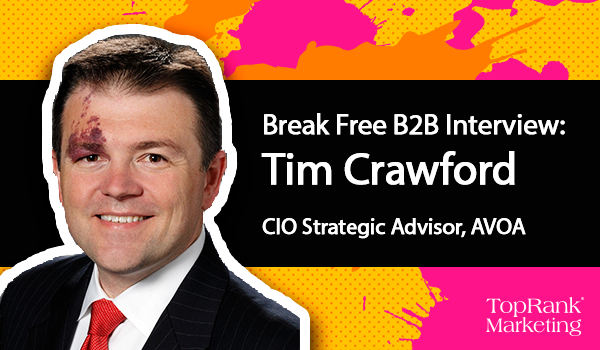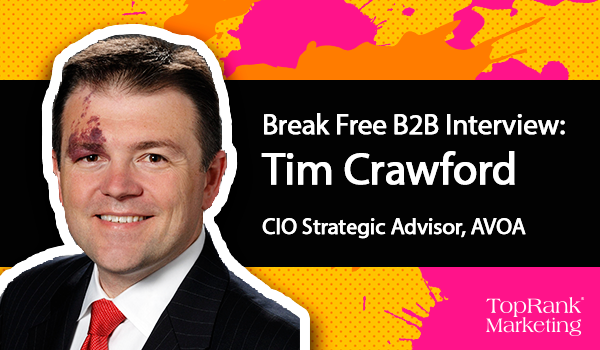
Just what is a B2B influencer, and what do they actually look like?
In our new third season of Break Free B2B Marketing video interviews we’re having in-depth conversations with an impressive array of top B2B influencers, exploring the important issues that each expert is influential about.
Successful B2B influencers have a rare mix of the 5 Ps — proficiency, personality, publishing, promotion, and popularity — as our CEO Lee Odden has carefully outlined in “5 Key Traits of the Best B2B Influencers.”
Ticking all of those boxes is Tim Crawford, CIO strategic advisor at AVOA, who we’re thrilled to be profiling today.
One way for B2B marketers to break free is by looking at what successful C-Level executives are doing and thinking. This is especially true in the middle of an unprecedented year, where what is “normal” for any business owner or leader is almost constantly changing.
Tim Crawford has a unique insight into the minds of C-Level executives. He’s gained this both by spending over a decade both being a CIO himself and spending nearly as much time working as a professional consultant. Frequently being quoted in publications like the Wall Street Journal and Forbes while hosting popular podcasts like CIO in the Know and CxO in the Know are just a few of Tim’s credentials when it comes to addressing the executive suite.
In case you didn’t already know, a CIO, also known as a company’s Chief Intelligence Officer, is the person in charge of its IT (information technology) department. Tim Crawford was invited to be one of the expert speakers during Season 3 of the Break Free B2B Marketing interview series because of his vast experience surrounding CIOs.
This expertise is especially relevant right now as the world’s workforce is changing as a result of the Covid-19 pandemic. How do you safely manage a secure remote workforce? How do you approach the “new normal” and how do you speak to those looking for assistance within this dynamic landscape? These questions, and more, will be answered during today’s hour-long interview between Tim and TopRank’s own president and co-founder Susan Misukanis.
Break Free B2B Interview with Tim Crawford
If you’re interested in checking out a particular portion of the discussion, you can find a quick general outline below, as well as a few excerpts that stood out to us.
- 1:53 – Tim’s New Normal
- 3:40 – Unexpected gains for CXOs in the last three to six months
- 5:28 – Faulty plans
- 5:46 – Tim talks about what he calls the “virus crisis”
- 7:45 – How the workforce adjusts to working from home
- 10:17 – Diversifying supply chains
- 12:04 – Defending against phishing
- 14:59 – Protecting privacy for corporations and WFH employees
- 17:10 – How do CIOs deal with the new habits required for at-home workers?
- 18:16 – Working from home distractions
- 21:20 – CIOs partnering with HR
- 24:06 – IT and critical thinking
- 26:04 – It’s okay to schedule time to think
- 27:50 – How do businesses work through uncertainty
- 31:46 – Pandemic preparedness
- 33:26 – How to go back or move forward with office culture post-crisis
- 38:15 – How would you counsel CIOs who are “holding” right now?
- 43:57 – Tim’s approach to engaging in B2B partnerships
- 52:41 – The differences between B2B and B2C influencers and partnerships
- 56:30 – Tim’s last piece of advice
Susan: We’ve talked about security, privacy, supply chain, human capital management, and economic impact. Is there another category that we didn’t cover and should, because this is an issue and you’re dealing with in the CXO community and counseling about that?
Tim: There is a lot of what we do, especially in I.T., is based on a process, right — you mentioned it earlier. People process technology. It’s a guideline that’s been used for several decades. The challenge is that I.T. — to a large degree — has lost a critical component over the decades. We’ve gotten so focused on things like best practices and so focused on processes that we have actually lost a lot of the ability to do critical thinking. Case in point: think about work from home.
When you have a support organization that is used to supporting corporate networks, it’s usually well defined. You know the technologies that are usually in play, you know the equipment that the user is going to be connecting from. There might be some other variables in the mix, but for the most part there are known quantities.
When you get to work from home, it’s all over the map. You have no idea what you’re walking into. How is the connectivity, which Wi-Fi technology are they using? Is it broadband? Is it DSL? Is it something else? You just don’t know what technology, or are they using a Mac now when they’re accustomed to a Windows system? Are they using a nonstandard system that doesn’t have a corporate image on it? And what other things are running on that system? And do you have kids that are also using that system and might be downloading things on it? Do you have a lot more variables that come into play? So it’s probably important now more than ever.
It’s been true before, but it’s now more than ever important that we start to think about critical thinking. You have to logically kind of walk through a process and think about how all of these other aspects come into play. And that’s not something that we have been teaching our I.T. teams. And frankly, this is not something that we’ve seen in the entire ecosystem, is this critical thinking. But more-so going forward, we will have to rely on that, because as things change, once we get past the virus crisis, once we start to escape the economic crisis. Critical thinking will be far more important. And we see that in the social impact. I mean, we can see it in our everyday lives, whether it’s around racial injustices, the way people are treated, the social impact, the sustainability of organizations, all of these are going to require critical thinking much more than we have in the past.
“In our everyday lives, whether it's around racial injustices, the way people are treated, social impact or the sustainability of organizations, all are going to require critical thinking much more than we have in the past.” @tcrawford Click To TweetSusan: You see this industry kind of rallying around that critical thinking need? And, you know, services and so forth, opening up new industries, opening up, or gosh, “This is Tim and x and a few executives.” And you’re planting the seeds.
Tim: Yeah, unfortunately, I wish it was the former. But today it’s the latter. We are just planting the seeds and frankly hoping that they germinate. I think they will for a number of different reasons this time more than in past years and past events that we’ve experienced. But the reality is that most people are still kind of fighting through the virus crisis and all the impact that comes from it. Here in California, we went from one shutdown to opening things up and now we’re back in the last couple of days here to another shutdown. So you know, it’s how do you work through that from a business standpoint — and forget about B2C — that’s even more complicated.
But from a B2B standpoint, it’s just as complicated. So we have to think beyond that once we get past the virus crisis. And I have a whole separate range of discussion we could go into, but around the virus crisis, the economic crisis, and the social impact. At the end of the day, all of this is based off of uncertainty around the virus. Once we get certainty around the virus, that will have a dramatic impact on choices. We make things we do. It will also start to impact the economic crisis that we’re all feeling. And it will start to create clarity around the social impact long term. The virus certainty is what we absolutely need to be focused on. And whatever we can do to drive toward that from there, then we can get into these other aspects.
As we start to think about how we come out of this at the end, assuming that you do, you are one of the lucky ones that do come out at the end, because let’s face it, there are a lot of businesses that will not survive the next six months as we get through the virus crisis, because the reality is we won’t see a vaccine in mass, at least here in the U.S., for at least six to nine months.
I was interviewed by the Wall Street Journal recently, and one of the questions that came to me was when do we start to get back to that rebuilding process? And this is a discussion that took place a couple weeks ago. But at that point in time, I said Q3 of 2021. Now, this is before we had hit Q3 of 2020. And everybody on the call kind of like went, “that far out?!” I’m like, let me play it out for you. And I walked through my thinking around it and they all came around and realized that, OK, I understand how this kind of plays out. So I think we have to hunker down and be in it for quite a while longer here and just be realistic about it. But once we start to get in that mode, we’ll start to get more innovative, too.
“I think we have to hunker down and be in it for quite a while longer here and just be realistic about it. Once we start to get in that mode, we'll start to get more innovative.” @tcrawford Click To TweetKeep your eye on the TopRank Marketing Blog and subscribe to our YouTube channel for more Break Free B2B interviews. Also check out episodes from season 1 and season 2.
Take your B2B marketing to new heights by checking out out previous season 3 episodes of Break Free B2B Marketing:
- Episode 1: Kevin L. Jackson, GC GlobalNet — The Future of Cloud Computing



